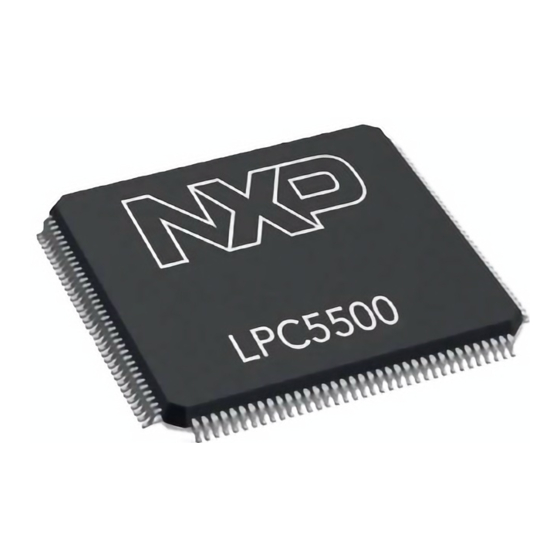Table of Contents
Advertisement
Quick Links
AN13449
Introduction to Dual USB port on LPC5500/LPC54600 Series
Rev. 0 - 11 November 2011
1 Introduction
1.1 Dual-USB introduction
LPC4300 series, LPC54000 series, and LPC5500 series, contain the feature
called dual-USB interface. The feature helps to set the LPC portfolio apart from
its competitors. Most of these parts, such as, LPC5500 series, has High-Speed
(HS) USB and Full-Speed (FS) USB with on-chip PHY. The dual-USB parts
provide up to 480 Mbit/s throughput, which can meet high-speed data transfer
requirement for any MCU application.
Unlike the competitors with only FS USB PHY, the dual-USB parts contain both
FS and HS on-chip PHY, which can greatly reduce design complexity.
Figure 1. LPC5500 series block diagram
Contents
1
Introduction......................................1
1.1
Dual-USB introduction................. 1
1.2
definition.......................................2
2
Why high-speed USB...................... 3
2.1
..................................................... 3
2.2
Larger packet length.................... 3
2.3
application....................................4
3
SDK................................................. 6
3.1
USB stack configurations.............8
3.2
Hardware connection................... 8
3.3
USB device example....................8
4
Hardware design........................... 10
5
Summary....................................... 12
6
Reference......................................12
7
Revision history............................. 12
Application Note
Advertisement
Table of Contents

Summary of Contents for NXP Semiconductors LPC5500 Series
-
Page 1: Table Of Contents
The feature helps to set the LPC portfolio apart from ............. 3 its competitors. Most of these parts, such as, LPC5500 series, has High-Speed Larger packet length....3 (HS) USB and Full-Speed (FS) USB with on-chip PHY. The dual-USB parts... -
Page 2: Usb History, Standard, And Speed Definition
NXP Semiconductors Introduction Figure 2. LPC54600 series block diagram The dual-USB interface enables numerous interesting and useful applications, as seen on LPC5500 MCU Series. 1.2 USB history, standard, and speed definition USB Implementers Forum (USB-IF), a non-profit organization that maintains the USB documents and compliance programs, regulates the USB. -
Page 3: Why High-Speed Usb
NXP Semiconductors Why high-speed USB Table 1. USB revisions Standard Also known as Year introduced Max. data transfer speed Cable length USB1.1 Full Speed USB 1998 12 Mbps USB2.0 Hi-Speed USB 2000 480 Mbps USB3.2 Gen1 USB3.0/USB3.1 SuperSpeed 2008 5 Gbps USB3.2 Gen2... -
Page 4: Example For Usb Hid Mouse Application
NXP Semiconductors Why high-speed USB Table 2. Packet size Max. packet size Transfer type Control 8, 16, 32, 64 Bulk — 8, 16, 32, 64 Interrupt Up to 8 up to 64 Up to 1024 Isochronous —- up to 1023 up to 1024 2.3 Example for USB HID mouse application... - Page 5 NXP Semiconductors Why high-speed USB Figure 5. HS HID mouse latency between button press and USB send data The interrupt transfer interval can also be seen from USB data lines signal: • In FS USB: the minimum interrupt transfer interval is 1 ms.
-
Page 6: Getting Started With Usb Demo With Sdk
NXP Semiconductors Getting started with USB demo with SDK Figure 7. USB data line signal: HS interrupt transfer interval: 125 us 3 Getting started with USB demo with SDK This section provides a hands-on guide to help you start to evaluate USB demo with SDK. Let us take the LPC55S69 as example. - Page 7 NXP Semiconductors Getting started with USB demo with SDK Figure 8. LPC55S69 EVB board Table 3. LPC55S69 EVB board Circuit reference Description LPC55Sxx USB0 (FS) micro AB port connector LPC55Sxx USB1 (HS) micro AB port connector Link2 Debug Probe connector...
-
Page 8: Usb Stack Configurations
NXP Semiconductors Getting started with USB demo with SDK For more details about this board, see Getting Started with the LPC55S69-EVK Evaluation Board. 3.1 USB stack configurations 3.1.1 Enable/disable dual USB ports To switch between USB0 (FS) and USB1 (HS). Change the macro in usb_device_config.h... - Page 9 NXP Semiconductors Getting started with USB demo with SDK 3.3.2 MSC example Demo project location: \boards\lpcxpresso55s69\usb_examples\usb_device_msc_ramdisk Change the macro: #define TOTAL_LOGICAL_ADDRESS_BLOCKS_NORMAL (360U) Then, RAM disk size can meet the minimum requirement of PC MSC test software: CrystalDiskMark • FS USB: Buck transfer speed can reach 1.14 MB/s. See Figure 9 for test result.
-
Page 10: Hardware Design
NXP Semiconductors Hardware design Figure 10. HS USB RAM disk test speed For details, see Example for USB HID mouse application. 4 Hardware design Both FS and HS USB ports contain on-chip PHY to make the schematic design much simpler. - Page 11 NXP Semiconductors Hardware design Figure 11. FS USB port schematic Figure 12. HS USB port schematic For USB clock source: • FS USB ports for device operation. The external crystal is optional since FS USB device support crystal less operation.
-
Page 12: Summary
1. Dual USB feature introduction in LPC54600 and LPC5500 series. 2. Comparison between HS and FS USB and the advantage for using HS USB. 3. Hands-on guide to explore USB feature using MCUXpresso SDK (LPC5500 series). 4. USB hardware design tips for LPC54000 and LPC5500 series. - Page 13 Right to make changes - NXP Semiconductors reserves the right to make changes to information published in this document, including without limitation specifications and product descriptions, at any time and without notice. This document supersedes and replaces all information supplied prior to the publication hereof.


Need help?
Do you have a question about the LPC5500 Series and is the answer not in the manual?
Questions and answers